HUMMER H3 2008 User Guide
Manufacturer: HUMMER, Model Year: 2008, Model line: H3, Model: HUMMER H3 2008Pages: 416, PDF Size: 5.66 MB
Page 11 of 416
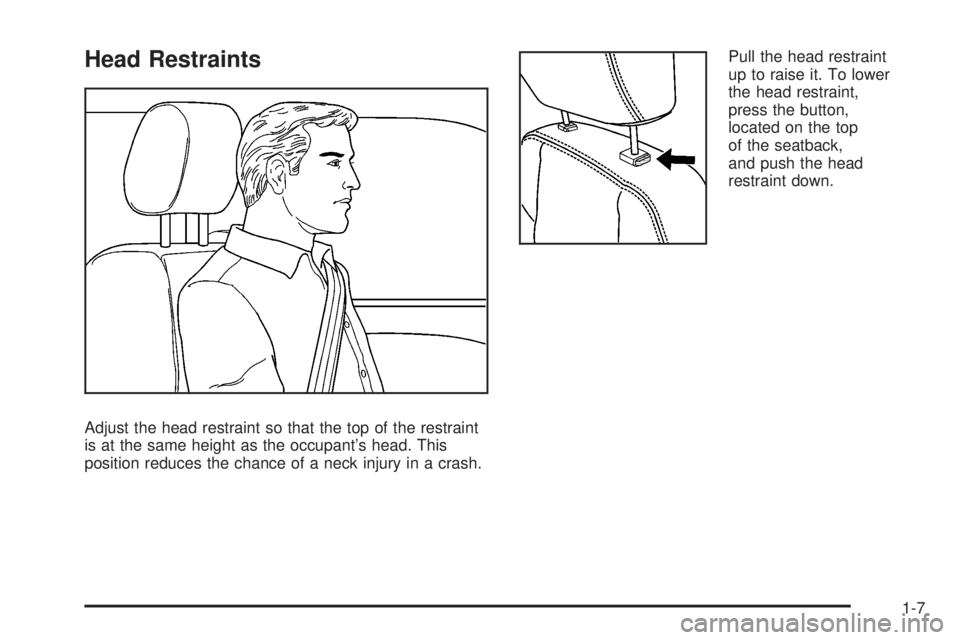
Head Restraints
Adjust the head restraint so that the top of the restraint
is at the same height as the occupant’s head. This
position reduces the chance of a neck injury in a crash.Pull the head restraint
up to raise it. To lower
the head restraint,
press the button,
located on the top
of the seatback,
and push the head
restraint down.
1-7
Page 12 of 416
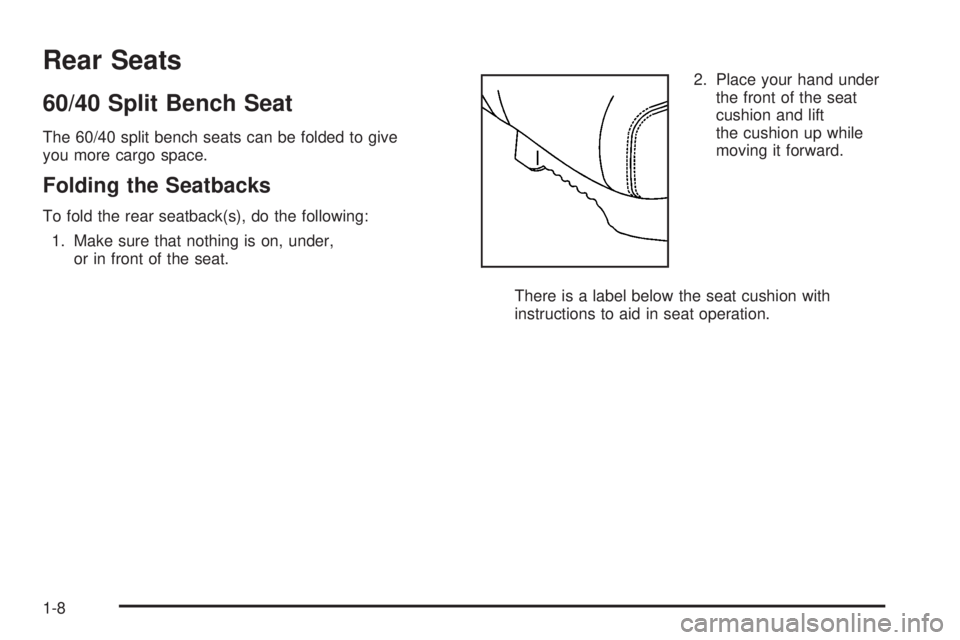
Rear Seats
60/40 Split Bench Seat
The 60/40 split bench seats can be folded to give
you more cargo space.
Folding the Seatbacks
To fold the rear seatback(s), do the following:
1. Make sure that nothing is on, under,
or in front of the seat.2. Place your hand under
the front of the seat
cushion and lift
the cushion up while
moving it forward.
There is a label below the seat cushion with
instructions to aid in seat operation.
1-8
Page 13 of 416
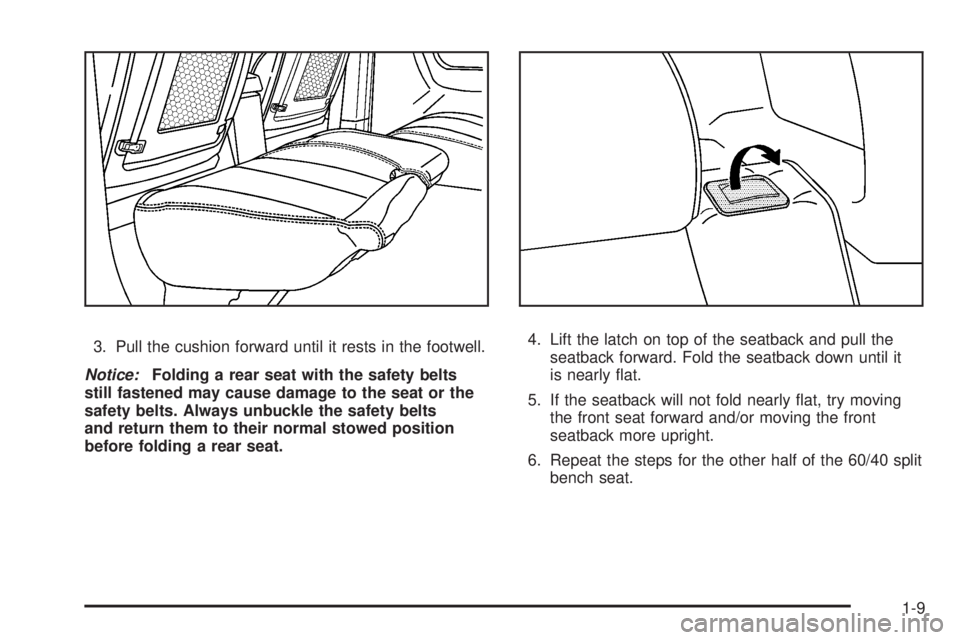
3. Pull the cushion forward until it rests in the footwell.
Notice:Folding a rear seat with the safety belts
still fastened may cause damage to the seat or the
safety belts. Always unbuckle the safety belts
and return them to their normal stowed position
before folding a rear seat.4. Lift the latch on top of the seatback and pull the
seatback forward. Fold the seatback down until it
is nearly �at.
5. If the seatback will not fold nearly �at, try moving
the front seat forward and/or moving the front
seatback more upright.
6. Repeat the steps for the other half of the 60/40 split
bench seat.
1-9
Page 14 of 416
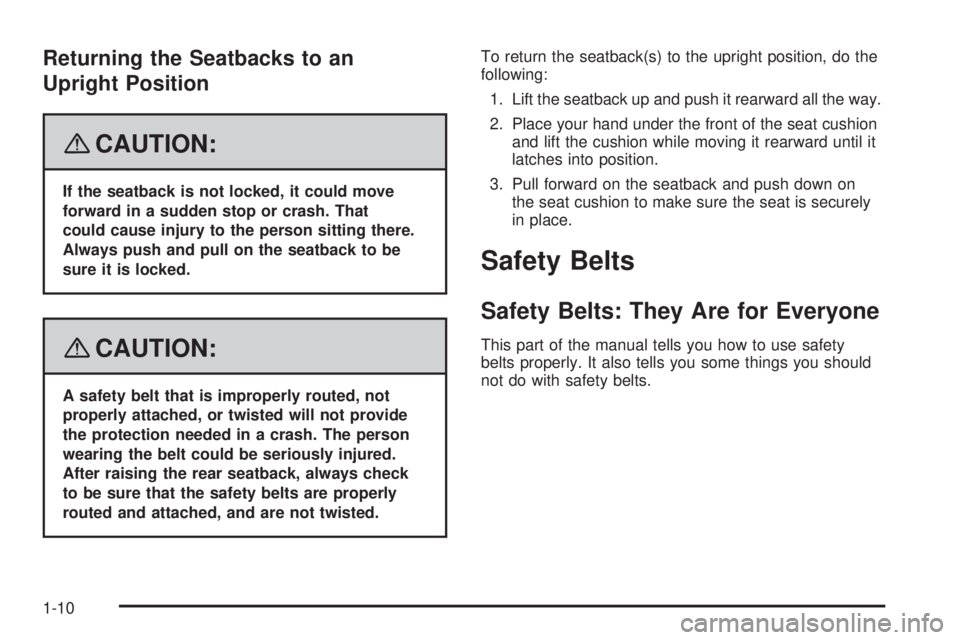
Returning the Seatbacks to an
Upright Position
{CAUTION:
If the seatback is not locked, it could move
forward in a sudden stop or crash. That
could cause injury to the person sitting there.
Always push and pull on the seatback to be
sure it is locked.
{CAUTION:
A safety belt that is improperly routed, not
properly attached, or twisted will not provide
the protection needed in a crash. The person
wearing the belt could be seriously injured.
After raising the rear seatback, always check
to be sure that the safety belts are properly
routed and attached, and are not twisted.To return the seatback(s) to the upright position, do the
following:
1. Lift the seatback up and push it rearward all the way.
2. Place your hand under the front of the seat cushion
and lift the cushion while moving it rearward until it
latches into position.
3. Pull forward on the seatback and push down on
the seat cushion to make sure the seat is securely
in place.
Safety Belts
Safety Belts: They Are for Everyone
This part of the manual tells you how to use safety
belts properly. It also tells you some things you should
not do with safety belts.
1-10
Page 15 of 416
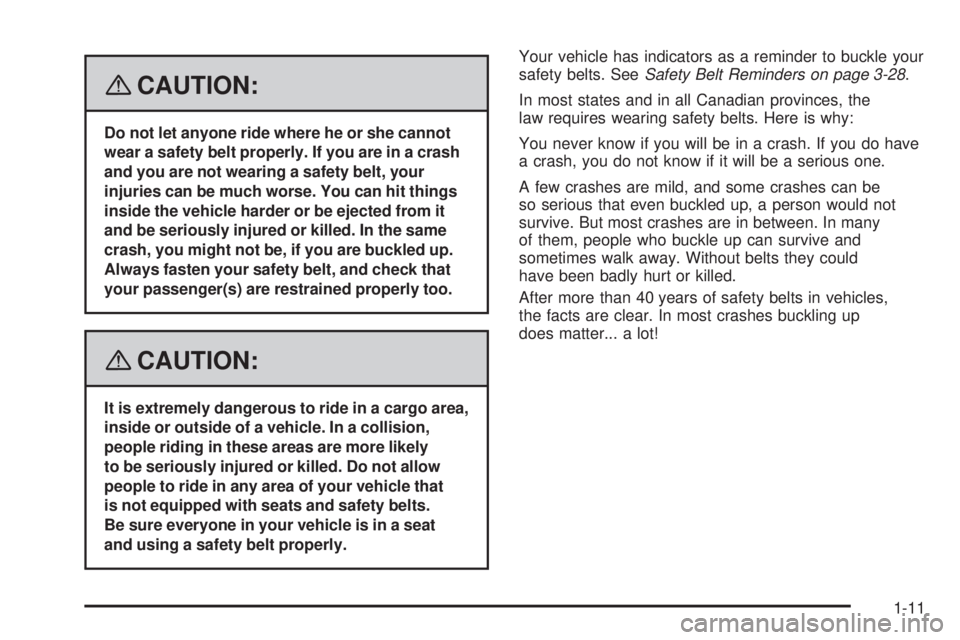
{CAUTION:
Do not let anyone ride where he or she cannot
wear a safety belt properly. If you are in a crash
and you are not wearing a safety belt, your
injuries can be much worse. You can hit things
inside the vehicle harder or be ejected from it
and be seriously injured or killed. In the same
crash, you might not be, if you are buckled up.
Always fasten your safety belt, and check that
your passenger(s) are restrained properly too.
{CAUTION:
It is extremely dangerous to ride in a cargo area,
inside or outside of a vehicle. In a collision,
people riding in these areas are more likely
to be seriously injured or killed. Do not allow
people to ride in any area of your vehicle that
is not equipped with seats and safety belts.
Be sure everyone in your vehicle is in a seat
and using a safety belt properly.Your vehicle has indicators as a reminder to buckle your
safety belts. SeeSafety Belt Reminders on page 3-28.
In most states and in all Canadian provinces, the
law requires wearing safety belts. Here is why:
You never know if you will be in a crash. If you do have
a crash, you do not know if it will be a serious one.
A few crashes are mild, and some crashes can be
so serious that even buckled up, a person would not
survive. But most crashes are in between. In many
of them, people who buckle up can survive and
sometimes walk away. Without belts they could
have been badly hurt or killed.
After more than 40 years of safety belts in vehicles,
the facts are clear. In most crashes buckling up
does matter... a lot!
1-11
Page 16 of 416
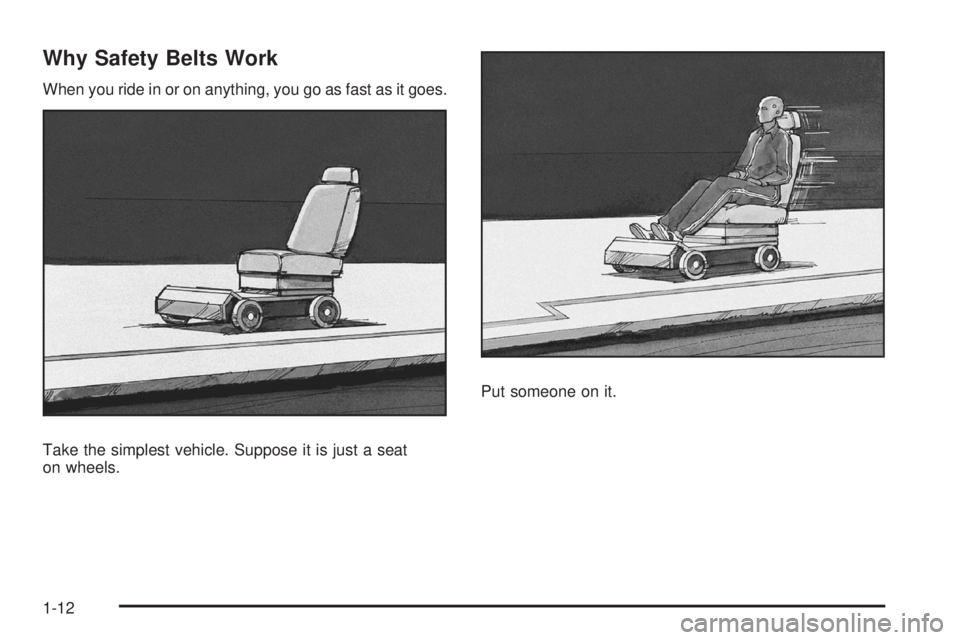
Why Safety Belts Work
When you ride in or on anything, you go as fast as it goes.
Take the simplest vehicle. Suppose it is just a seat
on wheels.Put someone on it.
1-12
Page 17 of 416
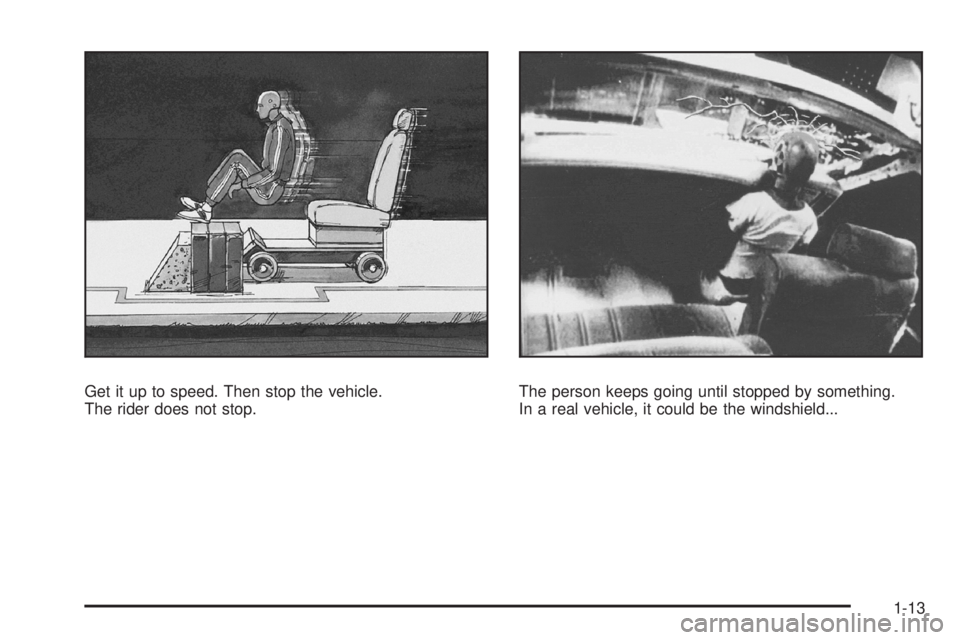
Get it up to speed. Then stop the vehicle.
The rider does not stop.The person keeps going until stopped by something.
In a real vehicle, it could be the windshield...
1-13
Page 18 of 416

or the instrument panel... or the safety belts!
With safety belts, you slow down as the vehicle does.
You get more time to stop. You stop over more
distance, and your strongest bones take the forces.
That is why safety belts make such good sense.
1-14
Page 19 of 416
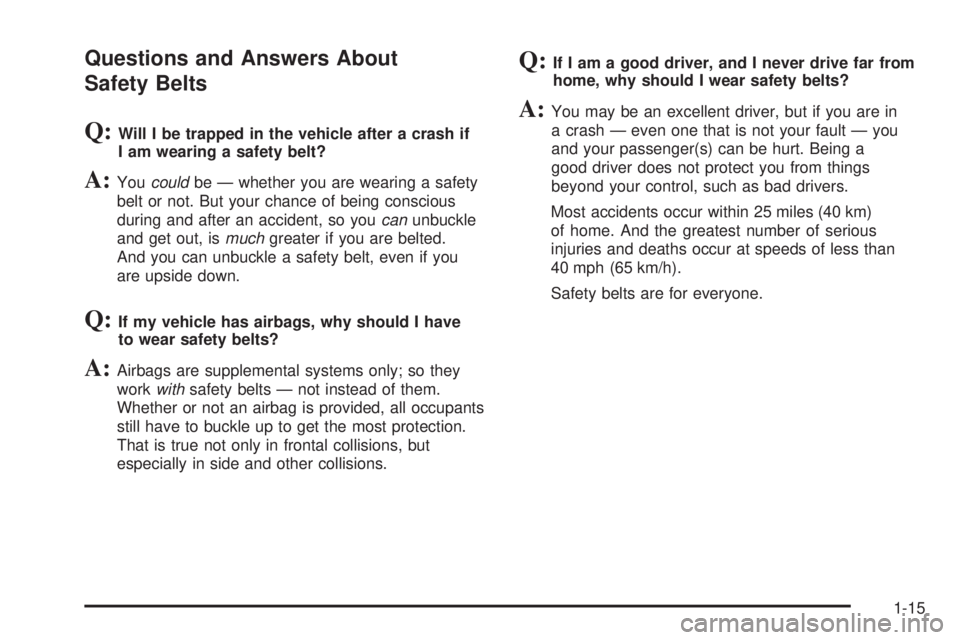
Questions and Answers About
Safety Belts
Q:Will I be trapped in the vehicle after a crash if
I am wearing a safety belt?
A:Youcouldbe — whether you are wearing a safety
belt or not. But your chance of being conscious
during and after an accident, so youcanunbuckle
and get out, ismuchgreater if you are belted.
And you can unbuckle a safety belt, even if you
are upside down.
Q:If my vehicle has airbags, why should I have
to wear safety belts?
A:Airbags are supplemental systems only; so they
workwithsafety belts — not instead of them.
Whether or not an airbag is provided, all occupants
still have to buckle up to get the most protection.
That is true not only in frontal collisions, but
especially in side and other collisions.
Q:If I am a good driver, and I never drive far from
home, why should I wear safety belts?
A:You may be an excellent driver, but if you are in
a crash — even one that is not your fault — you
and your passenger(s) can be hurt. Being a
good driver does not protect you from things
beyond your control, such as bad drivers.
Most accidents occur within 25 miles (40 km)
of home. And the greatest number of serious
injuries and deaths occur at speeds of less than
40 mph (65 km/h).
Safety belts are for everyone.
1-15
Page 20 of 416
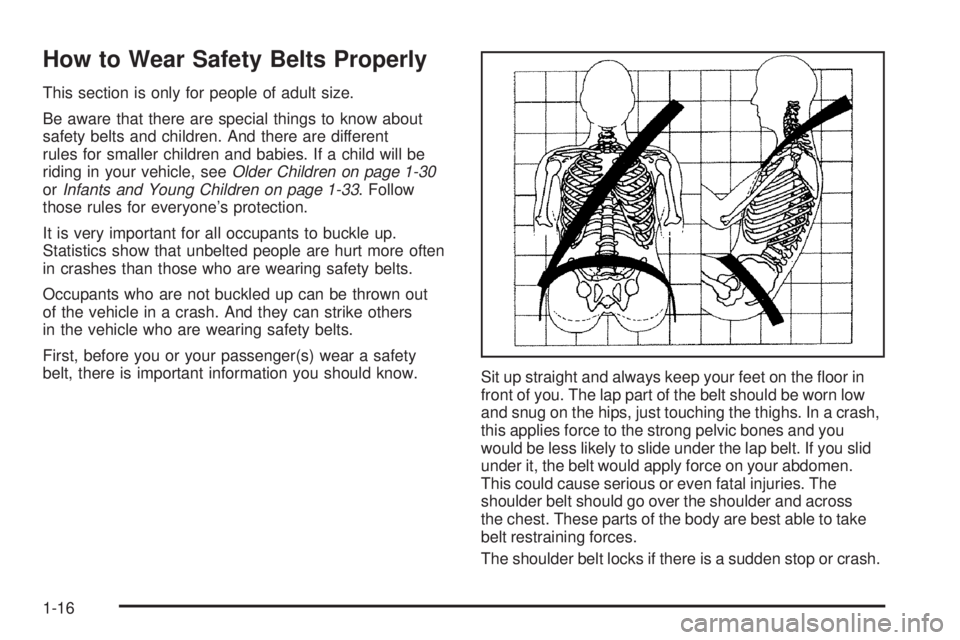
How to Wear Safety Belts Properly
This section is only for people of adult size.
Be aware that there are special things to know about
safety belts and children. And there are different
rules for smaller children and babies. If a child will be
riding in your vehicle, seeOlder Children on page 1-30
orInfants and Young Children on page 1-33. Follow
those rules for everyone’s protection.
It is very important for all occupants to buckle up.
Statistics show that unbelted people are hurt more often
in crashes than those who are wearing safety belts.
Occupants who are not buckled up can be thrown out
of the vehicle in a crash. And they can strike others
in the vehicle who are wearing safety belts.
First, before you or your passenger(s) wear a safety
belt, there is important information you should know.
Sit up straight and always keep your feet on the �oor in
front of you. The lap part of the belt should be worn low
and snug on the hips, just touching the thighs. In a crash,
this applies force to the strong pelvic bones and you
would be less likely to slide under the lap belt. If you slid
under it, the belt would apply force on your abdomen.
This could cause serious or even fatal injuries. The
shoulder belt should go over the shoulder and across
the chest. These parts of the body are best able to take
belt restraining forces.
The shoulder belt locks if there is a sudden stop or crash.
1-16